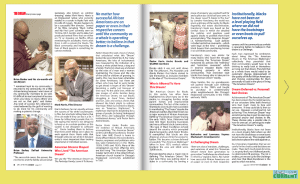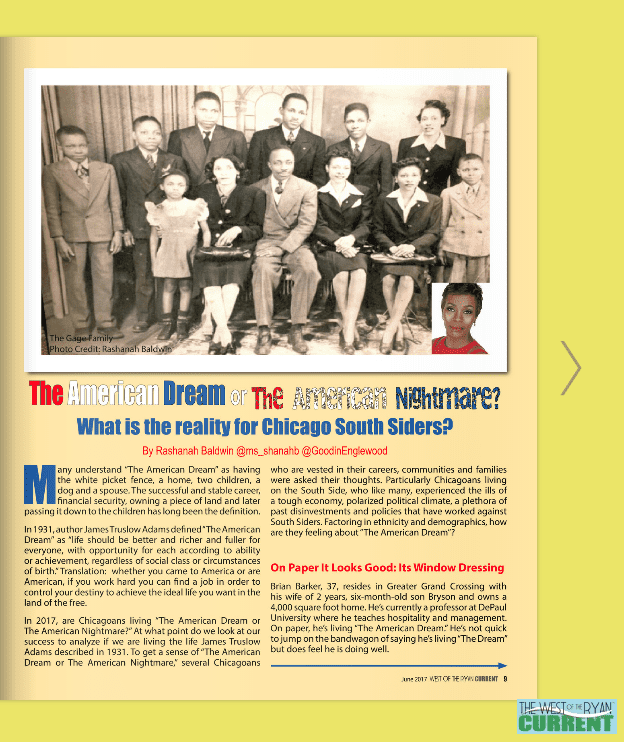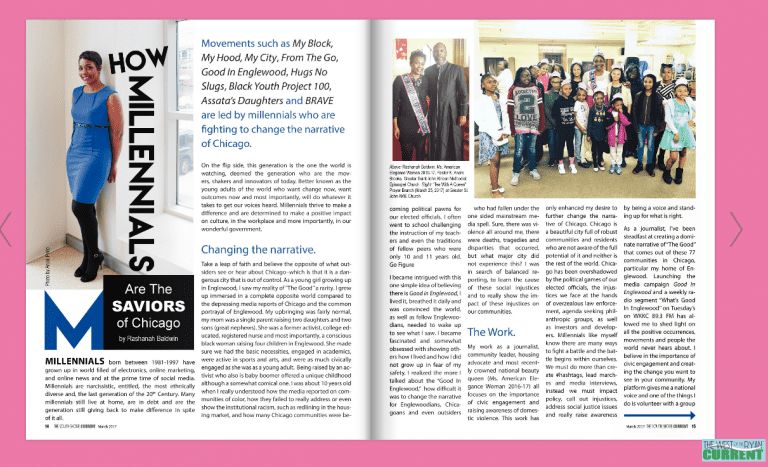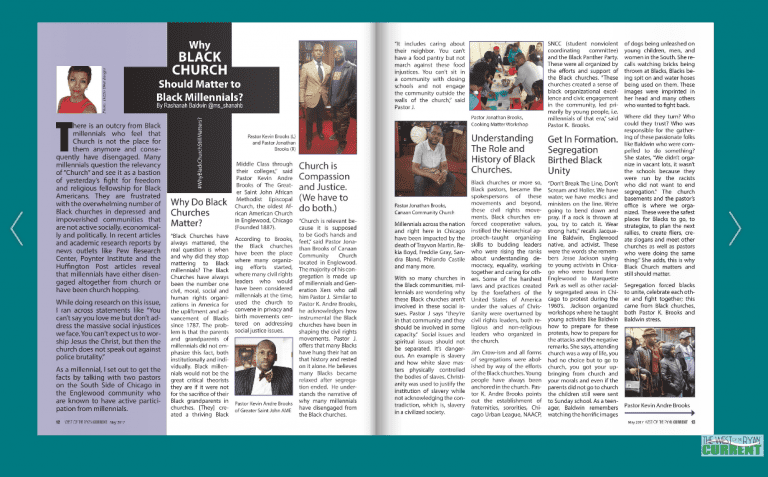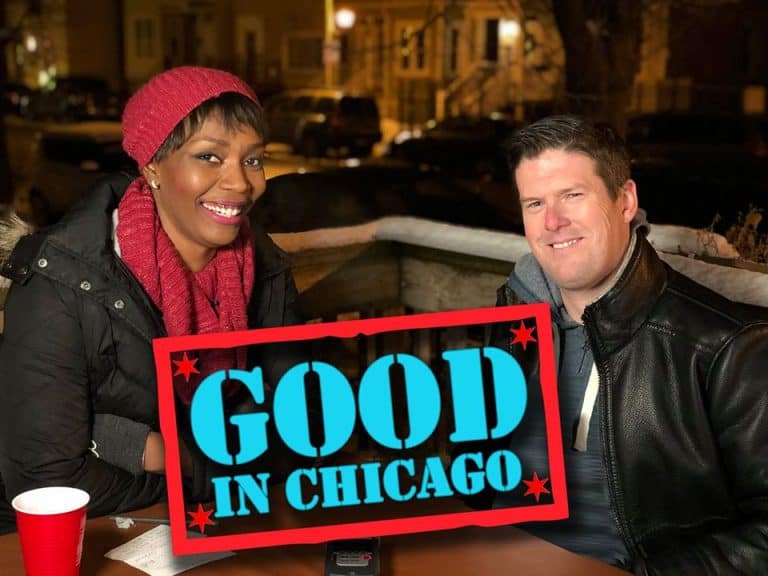The American Dream or The American Nightmare?
Many understand “The American Dream” as having the white picket fence. A home, two children, a dog, and a spouse. The successful and stable career, financial security, owning a piece of land, and later passing it down to the children, has been the definition.
In 1931, author James Truslow Adams defined “The American Dream” as “life should be better and richer and fuller for everyone, with opportunity for each according to ability or achievement, regardless of social class or circumstances of birth.” Translation, if you came to America or even are American if you work hard, you can find a job to control your destiny to achieve the ideal life you want in the land of the free.
In 2017 are Chicagoans living “The American Dream or The American Nightmare?” At what point do we look at our success to analyze if we are living the life James Truslow Adams described in 1931. To get a sense of “The American Dream or The American Nightmare,” several Chicagoans who are vested in their careers, communities and families were asked their thoughts. Mainly Chicagoans living on the South Side, who like many, experienced the ills of a tough economy, polarized political climate, a plethora of past disinvestments, and policies that have worked against South Siders. Factor in ethnicity and demographics, how do they feel about The American Dream?
On Paper It Looks Good: Its Window Dressing
Brian Barker, 37, resides in Greater Grand Crossing with his wife of 2 years, six-month-old son, and owns a 4,000 square foot home. He’s currently a professor at DePaul University, where he teaches hospitality and management. On paper, he’s living “The American Dream,” he’s not quick to jump on the bandwagon of saying he’s living “The Dream” but does feel he is doing well.
“I remained loyal to my community; I returned to my community; it’s a little disheartening because I want more of my community members to do well. It’s difficult to reach any level of success when you know so many others who are not on that path,” said Barker. Any level of success he’s obtained is overshadowed by the guilt of wanting to do more for his community and making a systemic change.
The successful career, the spouse, the beautiful home, and the family are a personal success, also known as window dressing, states Mark Harris. Harris is an Englewood native who currently resides in a condo in Hyde Park with his wife of 2 years. He also happens to be a successful film director. Several of his films, including “Black Coffee and My First Love,” can currently be seen on T.V. One, B.E.T., Centric, and to date, he’s produced over ten films that are either on T.V. or showing on Netflix. When mentioning his accolades, Harris adds there is still a concern for blacks. The black community and improving the lives of black people is something he cannot overlook.
Harris believes he can equally achieve the success of his white counterparts in the film but also feels by telling blacks that if he can make it, they can too is a lie. “I know by telling black people that it’s like saying this world is not designed to keep us in a certain position, or this system is not designed to suffocate us.” You’re leading them to believe that there are not things set in place to work against them. Harris adds that through unity, we can all do it because unity is more important than looking at personal or individual success.
American Sitcoms Shaped Who Lived “The American Dream”
We saw the “The American Dream” on The Partridge Family, Leave It To Beaver, Father Knows Best, and a host of shows that articulated what this dream looked like post World War II. For many Americans, the idea of inclusiveness is measured by the indicators of a house, a white picket fence, a dog, and a family anchored by a man and a woman role in maintaining the home and the child’s position in growing. In reality, there may have been a dream for some Americans, but there are others who have had to work harder to get ahead in hopes of this dream becoming a reality just because of their race. “At the same time, while we saw images of white families living the American Dream, we saw blacks struggling in Good Times, Sanford and Son, Julie and various shows that showed the black plight to achieve that hope. What is said for blacks was an American nightmare. A nightmare that had it’s beginning for a group of people kidnapped from Africa and subjugated through institutional slavery,” said Pastor Kevin Andre Brooks.
Brooks adds it was not until shows like The Jefferson’s, The Huxtables, and Family Matters that blacks started to see themselves as inclusive members in the idea of “The American Dream.”
Whose Is Allowed To Have This Dream?
The American Dreams for Blacks in this society are highlighted by what many see in the media, i.e., struggling families, single-parent homes, and impoverished communities. The fact of the matter is that blacks were much more successful in manifesting the dream despite the American realities. Black Wall Street was a significant example of the African American fulfilling “The American Dream” during the early 1900s when Tulsa, Oklahoma, had over 600 black booming businesses and many affluent black communities. This type of black excellence was echoed around the country which prompted shared prosperity. It exemplified, that blacks too are American and can climb the economic ladder. Yet this became a dream deferred or possibly “The American Nightmare” when in June 1921, the envious whites bombed the area and killed some 3,000 blacks.
Homeownership plays a significant role in defining “The American Dream.” The next best thing was putting down stakes in a community by owning a piece of property you worked hard for and a place you could call your own. In the classic novel “A Raisin In The Sun” by Lorraine Hansberry, the world was given a glimpse of the reality for American blacks regarding real estate discrimination. Hansberry’s book was based on her family’s story in which she detailed the policies and practices used against blacks to prohibit them from accomplishing the American Dream i.e., homeownership. Such policies included restrictive covenant – which was legal at the time banning a black buyer from purchasing homes in an all-white community.
Hansberry’s story was similar for many blacks who faced the struggle in achieving this “American Dream” and was told by way of polices like “redlining” and “restrictive covenant,” which in essence stopped blacks from purchasing a property in white communities. That restriction led to blacks not being able to take part in the American dream.
Many families like my grandparents still pushed through such redlining practices and fought to purchase in predominately white neighborhoods like Englewood.
A Challenging Dream
There are a lot of mindsets, challenges, and variations of what this “American Dream” meant from generation to generation. “I will always be a black man in America,” explains Harris. No matter how successful African Americans are on paper or even in their respective careers until the community as a whole is operating better, believing in that dream is a challenge.
While each man expressed his sentiments about living the “The American Dream or The American Nightmare,” collectively, they perceived that their communities would have to be thriving to look at themselves as living out that dream. They felt that as a whole, there would need to be systematic change, improvement of the quality of life for African Americans, and thriving communities for them to bask in the glory of living The American Dream.
